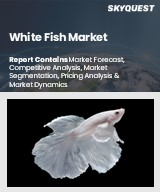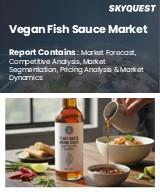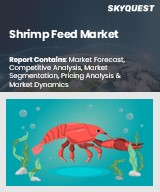
|
시장보고서
상품코드
1838289
흰살 생선 시장 규모, 점유율, 성장 분석 : 생선 유형별, 제품 유형별, 유통 채널별, 지역별 예측(2025-2032년)White Fish Market Size, Share, and Growth Analysis, By Fish Type (Tuna, Cod), By Product Type (Fresh, Smoked), By Distribution Channel, By Region - Industry Forecast 2025-2032 |
||||||
세계의 흰살 생선 시장 규모는 2023년에 1억 8,890만 달러로 평가되었고, 2024년의 1억 9,835만 달러에서 2032년에는 2억 9,305만 달러로 성장할 것으로 예상되며 예측 기간(2025-2032년)의 CAGR은 5.0%를 나타낼 전망입니다.
세계의 흰살 생선 시장은 단백질이 풍부한 식사에 대한 수요 증가, 양식 생산 증가, 건강과 웰니스에 대한 강한 주목에 의해 큰 성장을 이룰 전망입니다. 소비자는 고단백 저지방을 자랑하는 흰 생선의 영양면에서의 우위를 점점 인식하고 있습니다. 주요 지역에서의 양식활동의 강화는 시장 확대를 더욱 뒷받침할 것으로 예측됩니다. 게다가 식품가공업계는 냉동필레나 조리된 식품 등 다양한 제품에 흰살 생선을 많이 사용하여 안정적인 매출 성장을 가속하고 있습니다. 그러나 천연 생선 자원의 감소, 가격 변동, 대체 단백질과의 경쟁, 규제적 장애물 등의 과제는 시장의 발전을 저해할 수 있으며 지속적인 성장을 확보하기 위한 전략적 대응이 필요합니다.
자주 묻는 질문
목차
서론
- 조사의 목적
- 조사 범위
- 정의
조사 방법
- 정보 조달
- 2차와 1차 데이터의 방법
- 시장 규모 예측
- 시장의 전제조건과 제한
주요 요약
- 세계 시장 전망
- 공급과 수요 동향 분석
- 부문별 기회 분석
시장 역학과 전망
- 시장 개요
- 시장 규모
- 시장 역학
- 성장 촉진요인과 기회
- 성장 억제요인과 과제
- Porter's Five Forces 분석
주요 시장 인사이트
- 성공 핵심 요소
- 경쟁 정도
- 주요 투자 분야
- 시장 생태계
- 시장 매력 지수(2024년)
- PESTEL 분석
- 거시경제지표
- 밸류체인 분석
- 가격 분석
흰살 생선 시장 규모 : 생선 유형별&CAGR(2025-2032년)
- 시장 개요
- 참치
- 대구
- 바사
- 틸라피아
- 메기
- 대구
- 기타
흰살 생선 시장 규모 : 제품 유형별&CAGR(2025-2032년)
- 시장 개요
- 신선
- 훈제
- 냉동
- 가공
- 통조림
- 기타
흰살 생선 시장 규모 : 유통채널별&CAGR(2025-2032년)
- 시장 개요
- 직접 판매
- 전문점
- 슈퍼마켓
- 전문 시장
흰살 생선 시장 규모 : 지역별&CAGR(2025-2032년)
- 북미
- 미국
- 캐나다
- 유럽
- 독일
- 스페인
- 프랑스
- 영국
- 이탈리아
- 기타 유럽
- 아시아태평양
- 중국
- 인도
- 일본
- 한국
- 기타 아시아태평양
- 라틴아메리카
- 브라질
- 기타 라틴아메리카
- 중동 및 아프리카
- GCC 국가
- 남아프리카
- 기타 중동 및 아프리카
경쟁 정보
- 상위 5개사 비교
- 주요 기업 시장 포지셔닝(2024년)
- 주요 시장 기업이 채용한 전략
- 최근 시장 동향
- 기업 시장 점유율 분석(2024년)
- 주요 기업 프로파일
- 기업 상세 정보
- 제품 포트폴리오 분석
- 기업 부문별 점유율 분석
- 연간 매출 비교(2022-2024년)
주요 기업 프로파일
- Trident Seafoods(USA)
- Austevoll Seafood(Norway)
- Maruha Nichiro Corporation(Japan)
- Brim(Iceland)
- Thai Union Group(Thailand)
- High Liner Foods(Canada)
- Bumble Bee Seafoods(USA)
- Chicken of the Sea(USA)
- American Seafoods Group(USA)
- Pacific Seafood Group(USA)
- Cooke Aquaculture(Canada)
- Silver Bay Seafoods(USA)
- Popsie Fish Co(USA)
- Great Alaska Seafood(USA)
- Alaska Seafood Company(USA)
- Wulf's Fish(USA)
- Whidbey Island Seafood Company(USA)
- Baileys Harbor Fish Company(USA)
- Little Fish Company(USA)
- MI Great Lakes Fish Co(USA)
결론과 권고
KTH 25.10.22Global White Fish Market size was valued at USD 188.9 million in 2023 and is poised to grow from USD 198.35 million in 2024 to USD 293.05 million by 2032, growing at a CAGR of 5.0% during the forecast period (2025-2032).
The global white fish market is poised to experience significant growth, driven by the rising demand for protein-rich diets, an increase in aquaculture production, and a strong focus on health and wellness. Consumers are increasingly aware of the nutritional advantages of white fish, which boasts high protein and low fat. Enhanced aquaculture activities in key regions are expected to further support market expansion. Additionally, the food processing industry relies heavily on white fish for a variety of products, including frozen fillets and ready-to-eat meals, fostering consistent sales growth. However, challenges such as declining wild fish stocks, price fluctuations, competition from alternative proteins, and regulatory hurdles may impede market advancement, requiring strategic responses to ensure sustainable growth.
Top-down and bottom-up approaches were used to estimate and validate the size of the Global White Fish market and to estimate the size of various other dependent submarkets. The research methodology used to estimate the market size includes the following details: The key players in the market were identified through secondary research, and their market shares in the respective regions were determined through primary and secondary research. This entire procedure includes the study of the annual and financial reports of the top market players and extensive interviews for key insights from industry leaders such as CEOs, VPs, directors, and marketing executives. All percentage shares split, and breakdowns were determined using secondary sources and verified through Primary sources. All possible parameters that affect the markets covered in this research study have been accounted for, viewed in extensive detail, verified through primary research, and analyzed to get the final quantitative and qualitative data.
Global White Fish Market Segments Analysis
Global White Fish Market is segmented by Fish Type, Product Type, Distribution Channel and region. Based on Fish Type, the market is segmented into Tuna, Cod, Basa, Tilapia, Catfish, Haddock and Others. Based on Product Type, the market is segmented into Fresh, Smoked, Frozen, Processed, Canned and Others. Based on Distribution Channel, the market is segmented into Direct Sales, Specialty Store, Supermarket and Specialized Market. Based on region, the market is segmented into North America, Europe, Asia Pacific, Latin America and Middle East & Africa.
Driver of the Global White Fish Market
The dynamics of the global white fish market are significantly influenced by exports from major countries like Norway, Russia, and China. The rising demand for species such as cod, pollock, and tilapia in regions like North America and Europe is likely to open up fresh opportunities for vendors in the white fish sector. Additionally, improvements in strategic trade agreements, enhanced cold chain logistics, and the expansion of distribution networks have bolstered market accessibility, facilitating the movement of white fish products. As a result, the market is poised for growth, driven by these interconnected factors and evolving consumer preferences.
Restraints in the Global White Fish Market
The Global White Fish market faces significant challenges due to overfishing of key species like cod and haddock, which poses severe risks to marine ecosystems. Additionally, illegal, unreported, and unregulated (IUU) fishing continues to exacerbate the depletion of wild white fish stocks. As natural supplies dwindle and demand continues to rise, consumers are increasingly turning to alternative seafood options. The implementation of strict regulations on fishing practices, alongside other related concerns, is anticipated to negatively impact white fish consumption over time, potentially reshaping market dynamics and consumer preferences towards more sustainable alternatives.
Market Trends of the Global White Fish Market
The Global White Fish market is witnessing a significant shift towards sustainable and ethically sourced products, driven by changing consumer preferences and a strong emphasis on corporate sustainability. As awareness of environmental impact grows, white fish providers are increasingly adopting certified sourcing practices, seeking certifications from reputable organizations like the Marine Stewardship Council (MSC) and the Aquaculture Stewardship Council (ASC). This trend reflects a broader movement within the food industry, where transparency and ethical practices are becoming prerequisites for consumer trust. Companies that prioritize sustainability are likely to gain a competitive edge, aligning their offerings with the values of environmentally conscious consumers.
Table of Contents
Introduction
- Objectives of the Study
- Scope of the Report
- Definitions
Research Methodology
- Information Procurement
- Secondary & Primary Data Methods
- Market Size Estimation
- Market Assumptions & Limitations
Executive Summary
- Global Market Outlook
- Supply & Demand Trend Analysis
- Segmental Opportunity Analysis
Market Dynamics & Outlook
- Market Overview
- Market Size
- Market Dynamics
- Drivers & Opportunities
- Restraints & Challenges
- Porters Analysis
- Competitive rivalry
- Threat of substitute
- Bargaining power of buyers
- Threat of new entrants
- Bargaining power of suppliers
Key Market Insights
- Key Success Factors
- Degree of Competition
- Top Investment Pockets
- Market Ecosystem
- Market Attractiveness Index, 2024
- PESTEL Analysis
- Macro-Economic Indicators
- Value Chain Analysis
- Pricing Analysis
Global White Fish Market Size by Fish Type & CAGR (2025-2032)
- Market Overview
- Tuna
- Cod
- Basa
- Tilapia
- Catfish
- Haddock
- Others
Global White Fish Market Size by Product Type & CAGR (2025-2032)
- Market Overview
- Fresh
- Smoked
- Frozen
- Processed
- Canned
- Others
Global White Fish Market Size by Distribution Channel & CAGR (2025-2032)
- Market Overview
- Direct Sales
- Specialty Store
- Supermarket
- Specialized Market
Global White Fish Market Size & CAGR (2025-2032)
- North America (Fish Type, Product Type, Distribution Channel)
- US
- Canada
- Europe (Fish Type, Product Type, Distribution Channel)
- Germany
- Spain
- France
- UK
- Italy
- Rest of Europe
- Asia Pacific (Fish Type, Product Type, Distribution Channel)
- China
- India
- Japan
- South Korea
- Rest of Asia-Pacific
- Latin America (Fish Type, Product Type, Distribution Channel)
- Brazil
- Rest of Latin America
- Middle East & Africa (Fish Type, Product Type, Distribution Channel)
- GCC Countries
- South Africa
- Rest of Middle East & Africa
Competitive Intelligence
- Top 5 Player Comparison
- Market Positioning of Key Players, 2024
- Strategies Adopted by Key Market Players
- Recent Developments in the Market
- Company Market Share Analysis, 2024
- Company Profiles of All Key Players
- Company Details
- Product Portfolio Analysis
- Company's Segmental Share Analysis
- Revenue Y-O-Y Comparison (2022-2024)
Key Company Profiles
- Trident Seafoods (USA)
- Company Overview
- Business Segment Overview
- Financial Updates
- Key Developments
- Austevoll Seafood (Norway)
- Company Overview
- Business Segment Overview
- Financial Updates
- Key Developments
- Maruha Nichiro Corporation (Japan)
- Company Overview
- Business Segment Overview
- Financial Updates
- Key Developments
- Brim (Iceland)
- Company Overview
- Business Segment Overview
- Financial Updates
- Key Developments
- Thai Union Group (Thailand)
- Company Overview
- Business Segment Overview
- Financial Updates
- Key Developments
- High Liner Foods (Canada)
- Company Overview
- Business Segment Overview
- Financial Updates
- Key Developments
- Bumble Bee Seafoods (USA)
- Company Overview
- Business Segment Overview
- Financial Updates
- Key Developments
- Chicken of the Sea (USA)
- Company Overview
- Business Segment Overview
- Financial Updates
- Key Developments
- American Seafoods Group (USA)
- Company Overview
- Business Segment Overview
- Financial Updates
- Key Developments
- Pacific Seafood Group (USA)
- Company Overview
- Business Segment Overview
- Financial Updates
- Key Developments
- Cooke Aquaculture (Canada)
- Company Overview
- Business Segment Overview
- Financial Updates
- Key Developments
- Silver Bay Seafoods (USA)
- Company Overview
- Business Segment Overview
- Financial Updates
- Key Developments
- Popsie Fish Co (USA)
- Company Overview
- Business Segment Overview
- Financial Updates
- Key Developments
- Great Alaska Seafood (USA)
- Company Overview
- Business Segment Overview
- Financial Updates
- Key Developments
- Alaska Seafood Company (USA)
- Company Overview
- Business Segment Overview
- Financial Updates
- Key Developments
- Wulf's Fish (USA)
- Company Overview
- Business Segment Overview
- Financial Updates
- Key Developments
- Whidbey Island Seafood Company (USA)
- Company Overview
- Business Segment Overview
- Financial Updates
- Key Developments
- Baileys Harbor Fish Company (USA)
- Company Overview
- Business Segment Overview
- Financial Updates
- Key Developments
- Little Fish Company (USA)
- Company Overview
- Business Segment Overview
- Financial Updates
- Key Developments
- MI Great Lakes Fish Co (USA)
- Company Overview
- Business Segment Overview
- Financial Updates
- Key Developments



















